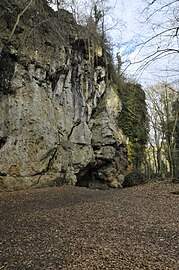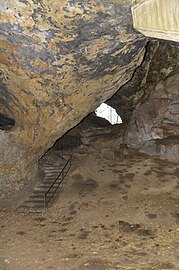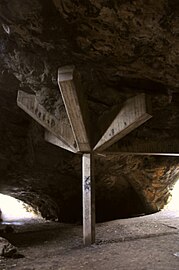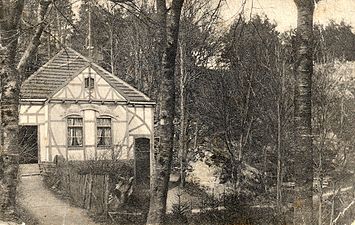Kakus cave
| Kakus cave
|
|
|---|---|
|
Big cave |
|
| Location: | Mechernicher Voreifel , Euskirchen district |
| Height : | 400 m above sea level NHN |
|
Geographic location: |
50 ° 32 '42 " N , 6 ° 39' 36" E |
| Geology: | Travertine |
| Type: | Karst cave |
| Discovery: | unknown, before our era |
| Lighting: | no |
The Kakushöhle is the larger of two caves in the Kakusfelsen ( Kartstein ) near the Dreimühlen district of Mechernich . It is one of the largest open caves in the Eifel and part of the 5.8 hectare nature reserve Kartsteinhöhlen with Kakushöhle, which was designated in 1932 .
A second small cave is located north of the large cave. Above the cave there is a plateau, which was bordered in the west by a section wall that made the plateau a refuge .
geology
The Kakushöhle is located in the up to 18 m high of travertine and tufa kakus rock, which is about 400 m above sea level. NHN and on which the plateau extends about 150 m in length. The Kartstein was created by the precipitation of lime, which probably came from karst springs.
The age of the rock could not yet be determined exactly, but is probably around 300,000 years. The water of the Weyerer Bach finally washed the caves out of the rock.
description
The Kakushöhle consists of a large church (up to 15 m high and 30 m wide) and an adjoining room, the dark chamber . The small cave that is 50 m north of the large cave is also called the Cold Hole .
history
The caves have always attracted people who used them and the plateau in a variety of ways. Finds show that the Kakus Cave was already visited by Neanderthals and then by ice age modern humans. About 12,000 years ago, in the late Paleolithic, reindeer hunters of the Ahrensburg culture pitched their tents at the caves.
In the west of the plateau is the section wall, which made it a refuge, as it is otherwise protected by cliffs. It is assumed that the terrain was already used in the Iron Age, then in the late Roman and Carolingian times. Older finds from the large cave and from the plateau probably come from Celts from the older Latène period (bronze fibers, iron slag on the plateau). The plateau probably served as a refuge in the first half of the 4th century to protect against the Franks invading the Roman Empire, as found Roman coins from this time suggest.
Finds from the 12th (Great Cave) and the 13th and 14th (Small Cave) centuries document short-term stays of humans in the later Middle Ages.
The Kakus rock is marked in the Tranchot map from around 1809 under the name “Roches caverneux” . In the topographical map of the Prussian first survey, the cave is referred to in 1846 as "CacusHöhle".
On August 5, 1902, Crown Prince Wilhelm paid a visit to the cave. In 1907 a bust of Kaiser Wilhelm II was erected on the so-called Kaiserhorst . The remnants of this bust are on the way from the café to the cave entrance.
The large cave was used in 1944/45 as a hall protected from air raids, a material store for a factory and a file store for the district administration; unfortunately the cave floor was leveled.
A restaurant built after the war near the cave entrance burned down in 1982 and was no longer allowed to be rebuilt.
archeology
In 1880 a J. Ruhr examined the cave, in 1900 a Prof. Fischer. In 1911 and 1913 the first major excavations took place under Carl Rademacher . The finds by C. Rademacher are now in the Roman-Germanic Museum in Cologne , but the remains of the fauna were largely destroyed during the Second World War . During the excavation of Rademacher in 1911, the primary focus was on obtaining finds.
In 1921 H. Heck and in 1939 LF Zotz carried out investigations in the caves. Zotz managed to find layers of finds that had not yet been examined in the small cave. After the Second World War, only one published detailed report of the excavation of Zotz was available, the finds were lost.
A. Herrenbrodt examined the cross-section from the Zotz excavation again in 1959. In 1970 H. Löhr carried out an excavation near the east entrance of the large cave, in 1977 again and again. a. in the area of the foundations for safety measures in the large cave. The finds from 1959 and 1970 are in the Rheinisches Landesmuseum Bonn .
Finds from the overburden of the older excavations are also in the Hürten Museum in Bad Münstereifel and in the Eifel Museum in Blankenheim . In addition to finds such as B. a Micoquekeil, scrapers and tips that come from humans, were fauna remains u. a. Discovered by giant deer, woolly rhinoceros, steppe bison, reindeer, wolf, musk ox, cave lion, horse, brown bear, cave bear, beaver, porcupine, marmot, mammoth and hyena.
tourism
The cave is freely accessible and can be easily reached from a parking lot at Landesstraße 115, where there is also a café. Visitors will also find public toilet facilities there. Entry to the caves is free. A circular path begins at the café, which initially leads past the remains of the bust of Kaiser Wilhelm II and the barbecue area to the main entrance of the Kakushöhle. This part of the path is barrier-free, stepless and also suitable for wheelchair users.
The circular path also goes around the Kakus rock and then leads to the plateau on which the entrance to the small cave is located and where the section wall can be viewed and walked on. There are display boards along the way that explain the history of the Kartstein.
Say

According to a popular legend of Hercules and Kakus , a giant named Kakus is said to have lived in the cave system. The legend of the Roman poet Virgil , which is in the Eighth Canto of his work Aeneid , was transferred from the Tiber to the Eifel. The cave is named after this (Eifler) Kakus legend.
Among other things, the Mechernich mountain official CA Eick handed down the (Eifler) saga of Kakus and Hercules in his book about Eifel water pipes:
“In gray antiquity, it is said, lived here in the beautiful, spacious cave a mighty robber, Kakus by name, who through greed and rawness terrified all the inhabitants of the surrounding area. Any means of extending his rule seemed fair to him, and anyone who did not willingly complied with his demands was horribly mistreated, mutilated, or even killed. One day another giant, named Hercules, came to the area and chose the neighboring Herkelstein as his home. But he lived in peace and harmony with his neighbors and protected them as best he could against the attacks of the predatory Kaku. And so it happened that a huge quarrel soon arose between the two of them, but it ended with Hercules smashing the cave of Kaku by throwing a huge boulder, and the monster himself lost his life. Who should not immediately think of the transplantation of the legend according to which Hercules killed the predatory giant Kakus on his way from Gaul to Italy in Latium? "
Another legend is about two farmers who, instead of going to church during Holy Week , preferred to play cards in the Kakushöhle. A stranger joined them and lost a great deal of gold to them. He suggested to the two that the first one to finish the card game should be the devil's guest forever. Blinded by the profit, the two agreed. Later they recognized the devil in the stranger, and so they secretly vowed that if they were saved they would never touch a card again and that they would honor Holy Week in the future. Nobody dared to be the first to finish the game, so they played for a few days until one of their worried wives found them and called the pastor. He rushed to the cave and ordered the devil to release them. At the sight of the crucifix the devil let go of the peasants, knocked an opening in the wall of the cave and angrily left the Kakus cave through it.
See also
literature
- Michael Baales: Kartstein near Mechernich / Eifel. A natural history and archaeological tour . Ed .: Research area Palaeolithic of the RGZM Mainz. Rheinland-Verlag, Monrepos Castle, Mechernich, ISBN 3-7927-1844-8 .
- G. Bosinski : The Kartstein. In: Northeastern Eifel foreland - Euskirchen, Zülpich, Bad Münstereifel, Blankenheim. Part II: Excursions (= Römisch-Germanisches Zentralmuseum Mainz et al. [Hrsg]: Guide to prehistoric and early historical monuments. Volume 26). Verlag Philipp von Zabern, Mainz am Rhein 1974, p. 114 ff.
- CA Eick : The Roman aqueduct from the Eifel to Cologne. With regard to the Roman settlements, fortifications and military roads that were initially located. Max Cohen & Son, Bonn 1867.
- H.-E. Joachim: The section wall on the Kartstein. In: Northeastern Eifel foreland - Euskirchen, Zülpich, Bad Münstereifel, Blankenheim. Part II: Excursions (= Römisch-Germanisches Zentralmuseum Mainz et al. [Hrsg.]: Guide to prehistoric and early historical monuments. Volume 26). Verlag Philipp von Zabern, Mainz am Rhein 1974, p. 122 ff.
- Hans-Eckart Joachim , Wighart v. Koenigswald , Wilhelm Meyer : Kartstein and Katzensteine near Mechernich in the Eifel (= Rheinischer Verein für Denkmalpflege und Landschaftsschutz [Hrsg.]: Rheinische Kunststätten, No. 435). 1st edition 1998. Printing and commissioning publisher: Neusser Druckerei and Verlag GmbH, Neuss, ISBN 3-88094-839-9 .
- Anton Könen: 1125 years of Weyer (871-1996) . Publisher: Mechernich-Weyer Association Cartel. 1996.
- Sophie Lange: Kakushöhle - legends of yore, stories of today. With a timetable. 1995.
- Hartwig Löhr: The Kartstein Cave reveals its secrets. In: District Euskirchen (Hrsg.): Jahrbuch des Kreis Euskirchen 1978. 1978, p. 20 ff.
- Alexander Sobotta: Kartstein rock experience - stepless to the Kakushöhle at Mechernich-Dreimühlen. In: District Euskirchen (Hrsg.): Yearbook of the District Euskirchen 2006. 2006, p. 46 ff.
Individual evidence
- ↑ Joachim, v. Koenigswald, Meyer, 1998, p. 6 f.
- ↑ Joachim, v. Koenigswald, Meyer, 1998, p. 8 f.
- ↑ a b c d Joachim, v. Koenigswald, Meyer, 1998, p. 9.
- ↑ Bosinski, 1974, p. 115.
- ↑ Bosinski, 1974, p. 120.
- ↑ Joachim, v. Koenigswald, Meyer, 1998, p. 12.
- ↑ Joachim, v. Koenigswald, Meyer, 1998, p. 21 f.
- ↑ a b c d Joachim, v. Koenigswald, Meyer, 1998, p. 25.
- ↑ Topographical Information Management, Cologne District Government, Department GEObasis NRW ( Notes ) (query from April 17, 2013)
- ↑ Könen, 1996, p. 53.
- ↑ a b Joachim, v. Koenigswald, Meyer, 1998, p. 10.
- ↑ Bosinski, 1974, p. 114.
- ↑ a b c d Hartwig Löhr, 1978, p. 22.
- ↑ Joachim, v. Koenigswald, Meyer, 1998, p. 9 f.
- ↑ a b Hartwig Löhr, 1978, p. 23.
- ↑ cf. Joachim, v. Koenigswald, Meyer, 1998, pp. 10-25.
- ↑ a b Alexander Sobotta, 2006, p. 47.
- ↑ cf. u. a. Sophie Lange: Kakushöhle - legends of yore, stories of today. 1995.
- ↑ CA Eick, 1867, p. 56.
- ↑ cf. Sophie Lange: Kakushöhle - legends of yore, stories of today. 1995. p. 5 f.
Web links
- Nature reserve "Kartsteinhöhle mit Kakushöhle" in the specialist information system of the State Office for Nature, Environment and Consumer Protection in North Rhine-Westphalia
- The Kakushöhle at Eiserfey
- Website of the city of Mechernich about the Kakushöhle
- Information film about the cave on rhein-eifel.tv
- Leaflet “Kakushöhle” with directions PDF









